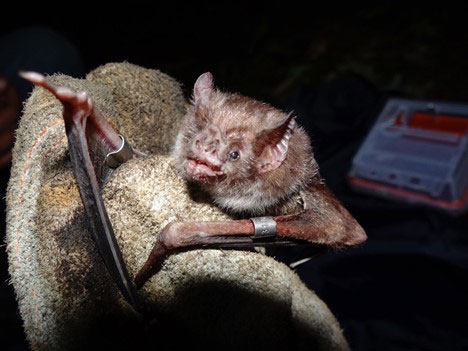Many human-infecting viruses, including the coronavirus responsible for causing COVID-19, are thought to circulate in wild animals before jumping into humans, a process known as zoonotic transmission. Accordingly, there has been a lot of recent interest in studying viruses in wild animals which have frequent contact with humans. However, since wild animals are infected by diverse viruses and very few of these infect humans, finding high-risk virus taxa is a needle in a haystack challenge. Making matters worse, for many newly discovered viruses, the only piece of information available is a genome sequence. Our team recently developed and validated machine learning methods that rank viruses by their ability to infect humans (“zoonotic potential”) using only their genome sequence. In our new study, we applied these models to viruses we discovered in common vampire bats, a widespread American bat that feeds nightly on the blood of domestic animals and humans.

Photo: Common vampire bat (Desmodus rotundus) captured in Peru as part of our long term monitoring study. Credit: Daniel Streicker
Vampire bats are already known to harbor several viruses of confirmed or suspected zoonotic importance. One virus of particular interest is Desmodus rotundus morbillivirus (DrMV), a close relative of the virus that causes measles in humans. Since other morbilliviruses can suppress the host immune system, our HFSP-funded work hypothesizes that DrMV might predispose vampire bats to infection by other viruses, including the best-known zoonosis from bats – rabies virus. However, the zoonotic potential of the many other viruses that infect these bats is uncertain, making it unclear how widespread the suspected effects of DrMV on bat immunity may be to human health.
To better understand the diversity of viruses that DrMV might interact with in vampire bats, we sampled bat populations across Peru and used high throughput sequencing to search for both known and unknown viruses. We discovered viruses from 17 families which infect mammals, including distant relatives of some viruses which cause human diseases including hepatitis E, hepatitis D, rotavirus, enterovirus, and coronavirus (although this vampire bat coronavirus was more closely related to a coronavirus which causes the common cold than to the one which causes COVID-19). We also detected rabies virus at a surprisingly high frequency in both bat saliva (the expected transmission route) and feces, suggesting these non-invasive samples are likely to be more useful for future monitoring of rabies infection in wild bats than previously imagined. We did not find DrMV in any of these samples, but this was expected since previous work has shown that this virus is more likely to be found in internal organs than in the samples tested here.
To evaluate the zoonotic potential of the newly discovered viruses, we compared the genome composition of vampire bat viruses to other viruses which have infected humans using machine learning. These analyses identified three viruses (one virus related to hepatitis E and two viruses related to the human-infecting parechovirus) which were higher priority for further study than all the others, illustrating how applying machine learning models to real-world sequence data can help determine which viruses merit further laboratory or field research.
Having a comprehensive picture of the viruses that co-occur with DrMV in vampire bat populations, we are now poised to investigate how the interactions of viruses within a wildlife host influence the risk of zoonotic transmission for the diverse array of viruses infecting vampire bats.


































